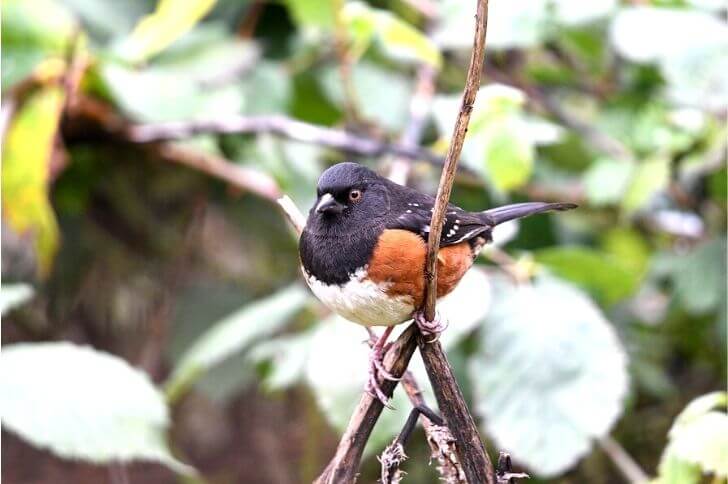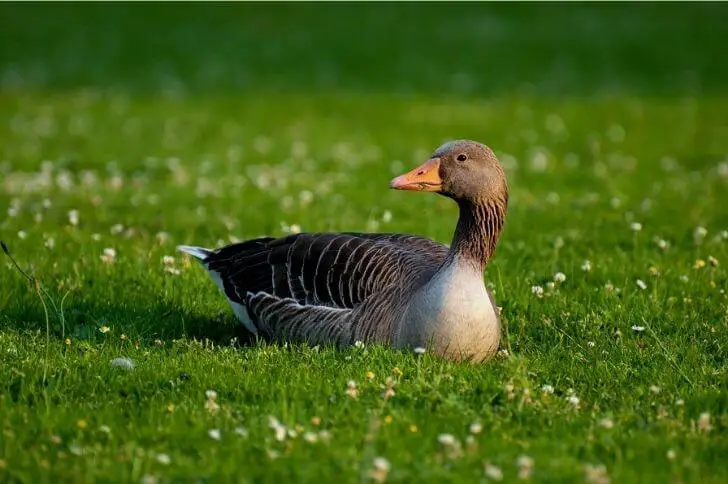In the beautiful City of Denver, Colorado, there are many feathered friends to be found. There are over 200 species of birds that have been documented in the area. Some common birds to spot in Denver are the American Robin, the House Finch, and the Anna’s Hummingbird.
Also, there are many more rare and interesting birds to be seen if you know where to look. With so many different types of birds, where should one go for bird watching?
Whether you are a new birder or an old timer like me, you’ll find the article below interesting. You’ll also learn about the diverse landscape and climate of the region that provides habitat for a wide range of birds, from soaring eagles to tiny hummingbirds.
List of Denver Birds
1. American Dipper
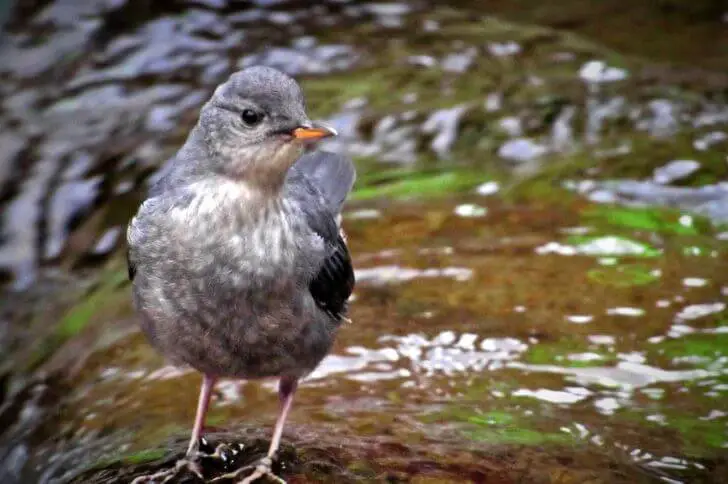
Also called water ouzels, American dippers are small, dull-colored birds that are found near streams and rivers in Denver, Colorado. The bird gets its name from its habit of dipping its head into the water to catch insects.
Identification:
How to identify these birds in Colorado? Whenever you are near a river or stream, be on the lookout for an all-gray round-bodied bird with a short tail and an almost non-existent neck. You can tell adults apart from juveniles by looking at their bills.
Adult American dippers have dark bills while immature birds spot yellowish bills.
Interesting facts:
The American dipper is a good swimmer and can even walk on the bottom of a stream bed. And because of these abilities, the bird can live and thrive in fast-moving rivers and streams. Also, its feathers don’t soak easily, allowing it to live in these habitats.
The bird nests in holes in rocks or trees along rivers. During the breeding season, this medium-size bird lays 4-5 eggs and can raise two broods each season.
2. American Goldfinch

Mostly found in Denver all-year round, the American goldfinch is a unique avian species with four subspecies that include eastern goldfinch and willow goldfinch. It is migratory, found in Eastern Colorado all Year and Western Colorado during their breeding months.
Identification:
The male is bright yellow with black wings and tail and a black cap; the female is duller. Immature goldfinches are light brown with white barred black wings and an olive head. Note their canonical bills and notched tails.
Interesting facts:
Goldfinches are found in open habitats such as fields, meadows and prairies. They feed on seeds, especially thistle seeds. The American goldfinch nests in trees, often building its nest near the top of a conifer.
This cheerful little bird is a welcome sight at any time of year. In summer, its bright yellow plumage is a cheerful addition to any garden. In winter, when many other birds have flown south for the season, the American goldfinch remains, providing a splash of color on dreary days. You can attract these exotic birds of Denver using sunflower seeds.
3. Broad-tailed Hummingbirds
Preferring high elevation areas, Broad-tailed Hummingbirds are one of the most common hummingbird species in Denver during their breeding season which starts in early spring. These small birds are known for their striking colors and aerobatic abilities.
Identification:
Hummingbirds are pretty easy to identify. The male broad-tailed hummingbird has a slender body, about the same size as an adult sparrow, with an iridescent green back, large round head and long bill. Note the ruby-colored throat.
Females have a similar-colored back, whitish belly and long bill. Their throats are also whitish.
Interesting facts:
Nesting season for broad-tailed hummingbirds begins in early spring and can last until late summer. Females build nests out of plant material, spider webs, and other bits of debris. The nests are usually built in trees or shrubs, and can often be found close to sources of food or water.
Both male and female broad-tailed hummingbirds help to care for the young. The parents will feed the chicks a diet of insects and nectar. Once they reach adulthood, these birds will migrate south for the winter months. If you want to see these birds, consider installing hummingbird feeders in your yard.
4. Northern Flicker

I believe the Northern flicker holds the record as the bird with the most alternative names. Also known as the clape, common flicker, heigh-ho, and 100 more names, this bird is also one of most beautiful wild birds in Denver.
Identification:
The Northern flicker is a medium-sized woodpecker that is found in Denver, Colorado. The western species has slightly different plumage from their eastern counterparts. In Denver, this bird species has a gray-brown back, a whitish rump, and gray spotted belly. Notice the red whiskers.
On the other hand, western northern flicker females are duller with dark barrings on their back and a red shaft.
Other facts:
The Northern flicker is a member of the genus Colaptes. It typically nests in trees, but will also nest in man-made structures such as houses and barns. The bird excavates a nesting cavity using its strong beak. The nesting cavity is usually about 10 inches deep and 4 inches wide. The Northern flicker often uses the same nesting site for many years.
Its diet consists mainly of insects, but the bird will also eat fruits, berries, and nuts.
5. Red-winged Blackbirds

Are there black birds in Denver? Yup, Red winged blackbirds are a species of true blackbird that is found all-year round in this region.
Identification:
The adult male is all black with a red shoulder patch, while the female is dark brown with heavy streaks. Both sexes are 6.8-9.1 inches in length and a body mass of up to 2.9 oz. Each wing can measure up to 5.7 inches long.
Other facts:
They are found in marshes and wetlands across Colorado including Denver. Red winged blackbirds are very social birds. They often form large flocks and can be seen perching in trees or flying overhead. They have a loud, distinctive call that sounds like “konk-a-ree.”
These birds are important to the ecosystem because they eat insects and help to control populations of pests. They also provide food for other animals, such as snakes and raccoons. Red winged blackbirds are protected under the Migratory Bird Treaty Act.
6. White-Breasted Nuthatch
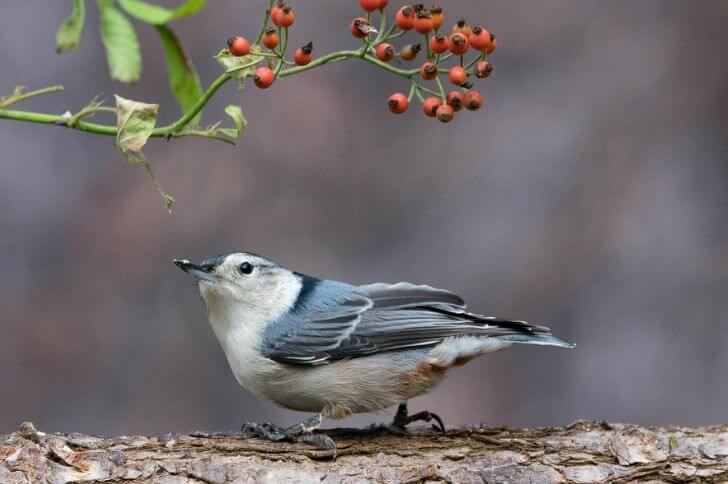
The white-breasted nuthatch is a small songbird of Denver. This cute nuthatch gets its name from its habit of wedging nuts into crevices in trees. It will then hammer them open using its strong bill.
Identification:
Can you identify white breasted nuthatches? If you have a bird feeder, you can check for a small bird, about 5 inches long, with a wingspan of 8 inches. It has blue-gray upperparts and a pale underside with a black cap. Note the rusty spots on its undertail coverts.
Other facts:
The white-breasted nuthatch is an acrobatic bird that can climb head first down tree trunks. It often hangs upside down while eating insects or searching for food. The nuthatch has a loud, nasal call that sounds like “yank-yank.”
When can you see their babies? White breasted nuthatches nest from early May and within a few weeks you can observe their fledglings and learn about their first few weeks of life. These common backyard birds in Colorado are all-year round residents.
7. Rock Pigeon
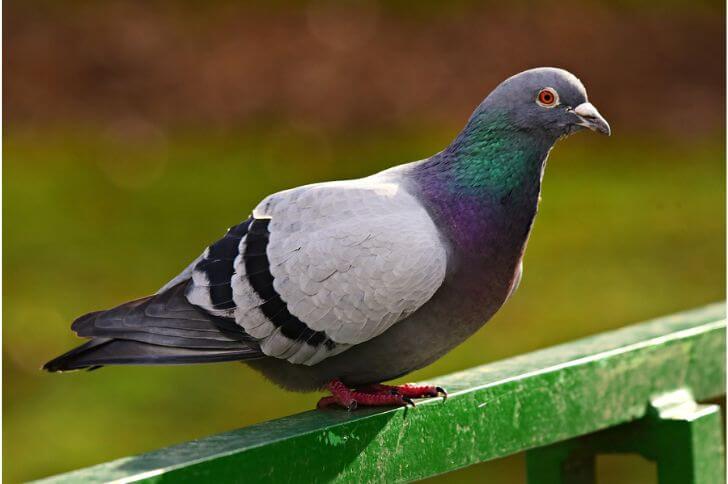
One of the most common doves in Denver are the rock pigeons. These native birds are not afraid of humans, making them easy to identify.
Identification:
The rock pigeon is a member of the bird family Columbidae. It has a stout body with a short neck, and rounded wings. On average, the adult body length ranges from 11.8-14.5 inches.
Adults are all gray with black barring on the wings. Notice the iridescent neck and cute pink legs.
Other facts:
They are common Denver birds in urban spaces including city parks. They prefer fruits and seeds. Rock pigeons are also great breeders, raising up to 6 broods each breeding season. This helps in keeping their population stable.
The average lifespan of a rock pigeon is 2-5 years in the wild, and up to 20 years in captivity. This Denver bird is considered an agricultural pest in some areas, due to its tendency to eat crops.
8. House sparrows
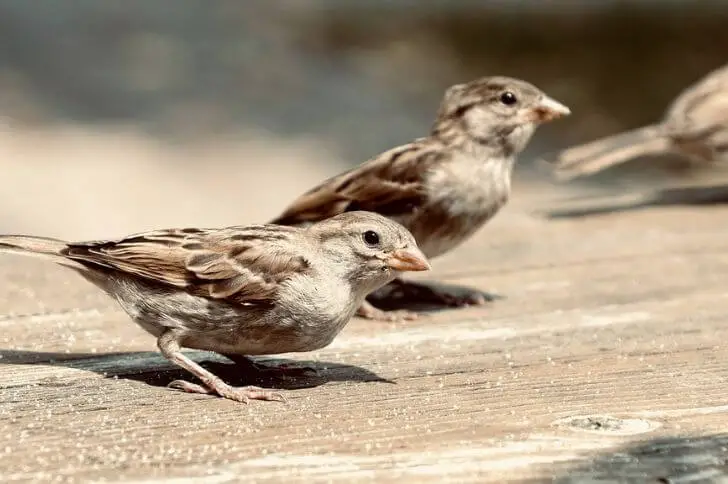
Is there an invasive species in Denver? Yes, house sparrows are a nuisance in most parts of America, including Colorado.
Identification:
They’re well known for their adaptability. These birds spot a round head, boxed tail and a short bill. You can also identify them by their chestnut nape, streaked brown back, and pale gray underparts.
Other facts:
These birds are known to invade backyard feeders. They chase common backyard birds from feeders, consuming most of the food. House sparrows are fast breeders, raising 2-4 broods of up to 8 babies per clutch during one breeding season.
9. House Finches

Almost the same size as house sparrows, House finches are a species of bird that are found all-year round within their range.
Identification:
They are small birds, about 5 inches, with reddish brown plumage. Male finches have bright red heads and breasts, while the female has a duller brownish color. Note their streaky belly and canonical bills.
Other facts:
House finches are seed eaters and they will often build their nests near human habitations. These Denver birds were once considered to be pests by farmers, but now they are appreciated for their beauty and their song.
These birds are relatively easy to attract to your yard. A good bird feeding station will work. They make excellent pets.
10. Blue Jay

A renowned member of the crow family, the blue jay is one of the most beautiful birds to watch. It is native to Colorado and can be found in wooded areas.
Identification:
Very distinctive plumage and features. The blue jay is known for its blue plumage on its back and head, black necklace and white underparts.
Their bodies are slender with long tail feathers. These birds also spot cute crests. The blue jay has a body length of about 10 inches and a wingspan of about 16 inches.
Other facts:
The blue jay is an omnivore and eats insects, nuts, and berries. Unlike house sparrows, blue jays raise only one brood per nesting season. Females lay bluish eggs that need about 3 weeks of incubation. In Denver, these beautiful birds are found during their non-breeding season.
11. Dark-eyed Juncos

When can you see dark-eyed juncos in Denver? These small birds are an all year round resident in Colorado.
Identification:
They are about the size of black capped chickadees. The adult is 5.5 – 6.3 inches in length, and is mostly gray. Note the pale bill, belly and long tail.
Other facts:
In North America, the dark-eyed junco is one of the most widespread and numerous birds. In winter, they are known to visit bird feeders and baths.
The dark-eyed junco has many different songs, which vary by region. The most commonly heard song is a simple trill, but some males sing much more complicated songs with multiple notes. These differences in song can be used to tell apart different subspecies of dark-eyed juncos.
12. American Kestrel

Are there birds of prey in Denver? American Kestrels are small birds of prey in Colorado. To identify them, look for:
Identification:
These birds are known for their bold hunting style and their distinctive plumage. American kestrels are sexually dimorphic, meaning that males and females have different plumage.
The male kestrel has rusty upperparts with bluish wings, while the female has brown upperparts with heavy barring. Both sexes have dark tails and short hooked bills.
Interesting facts:
The American kestrel is a small, agile falcon . Although they are the smallest member of the falcon family, they are still fierce predators.
Kestrels are very versatile hunters and will eat a variety of prey items. Their diet consists mainly of small mammals and insects, but they will also take reptiles, birds, and even carrion.
13. Black-billed Magpie

A black-billed magpie is a member of the Corvidae family, which includes crows, ravens and the blue jays above. The Corvid family is known for its high intelligence, and the black-billed magpie is no exception.
Identification:
This bird is not only smart, but also very beautiful, with its black and white plumage. Note its two-colored wings and diamond-shaped tail. The bird is 17 to 23 inches in length.
Other facts:
It prefers open habitats such as forests, grasslands, and even suburban areas. These birds are very social creatures and often live in groups of up to 20 individuals.
The black-billed magpie is an omnivore, meaning it eats both plants and animals. Some of its favorite food items include insects, berries, carrion, and small mammals.
14. House Wrens
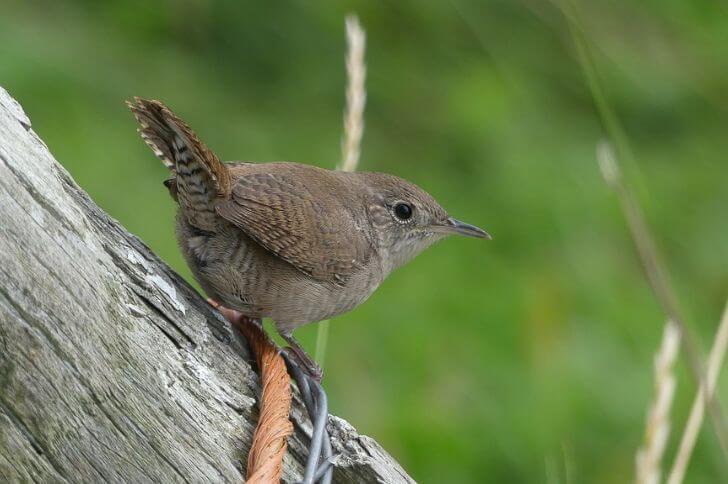
House wrens are a migratory bird species that is found in Denver during its non-breeding months. Small and fierce, here is what we know about this bird of Colorado.
Identification:
House wrens are small, brownish birds. Nothing about their plumage stands out. Their bodies are rounded with a very short neck. Wings and tails are short with heavy barring. Note the whitish throat. Males and females look alike.
Other facts:
House wrens like to nest in holes in trees or buildings. House wrens eat flying insects. During their nesting season, these birds lay pink-white eggs that are incubated for about two weeks. If you want to attract these Colorado birds, consider putting up nest boxes in your backyard.
15. Broad-winged Hawks
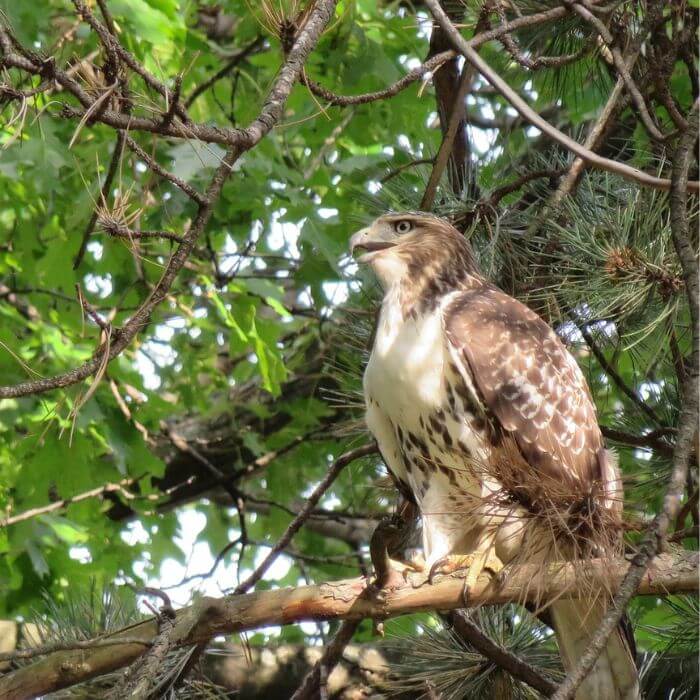
Are there hawks in Colorado? Broad-winged Hawks are one of the most common hawks in Denver. These versatile predators can be found in a variety of habitats, including forests, fields and even urban areas.
Identification:
Broad-winged Hawks are relatively small hawks, with a body length of about 16 inches. They have dark upperparts and whitish underparts with brownish bars. Their wings are dark brown. Note the white barred tails.
Other facts:
These birds hunt for a variety of small prey, including rodents, reptiles and insects. They often perch on high vantage points, such as trees or power lines, from which they can scan the ground for potential meals.
16. Song Sparrows

An all-year round resident in Denver, the song sparrow is a small bird that prefers open woodlands, farmlands, and urban areas across Colorado. The song sparrow gets its name from its musical song which is a series of chirps, trills, and warbles.
Identification:
These birds are almost the same size as the dark eyed juncos above. Adult song sparrows are heavily streaked brown with whitish bellies. Also these birds are 4.7-6.7 inches in length and each wing spans up to 9.5 inches.
Interesting facts:
These little birds play an important role in the Denver ecosystem. Not only do they help to control insect populations but they are also an important food source for other animals such as snakes, owls, and foxes. So next time you hear a beautiful song coming from the trees, take a moment to appreciate the singing sparrow.
17. Common Raven

How many calls does the common raven produce? As many as 33 unique calls including musicals.
Identification:
Pretty much the easiest birds to identify in Denver. Common ravens are a large passerine bird in the crow family. They are overall black with a thick bill and neck.
Other facts:
Common ravens are one of the few species of bird that has benefited from human activities. They can be found in open urban space, mostly with garbage, foraging for good.
During the breeding season, the birds’ nests are built on billboards and telephone poles in urban spaces and cliffs in the wild. Ravens have also been observed using tools to obtain food. They are social creatures and often live in pairs or small flocks.
18. Belted Kingfisher

The belted kingfisher is a member of the kingfisher family. If you are into bird watching, I highly recommend you go birding around rivers, swamps, and lakes where these avian species are found in abundance.
Identification:
It is a medium-sized bird with a large head and bill. The body is blue-gray with a white throat, breast and belly. Females have a rusty band around their belly which helps tell them apart from males of this unique bird species. The bird gets its name from the blue-gray band or “belt” around its chest.
Other facts:
In Colorado, it breeds along rivers, lakes, and ponds. The nesting season occurs in April and May with the parents digging the nest burrow together. Nest construction takes a week and the female lays 5-8 eggs. Kingfisher babies are fed fish and will also consume the skeleton and scales.
19. Barn Owl

There are various owls of Colorado but the barn owl is the only Tytonidae member in the Denver region. These owls are nocturnal predators that hunt for small mammals and insects. The barn owl gets its name from its habit of roosting in barns and other man-made structures.
Identification:
These owls are medium-sized with a wingspan of up to four feet. They have a white, heart-shaped facial disc surrounded by dark brown feathers. Rest of the body is grayish-brown with whitish underparts. The barn owl is one of the most widespread species of owl in the Americas.
Other facts:
These owls are known for their incredible hunting skills. They hunt small animals including mice and rabbits. They can raise up to 3 broods each nesting season. These owls are protected under the Migratory Bird Treaty Act, which makes it illegal to kill, capture, or sell them.
20. Blue-gray Gnatcatcher
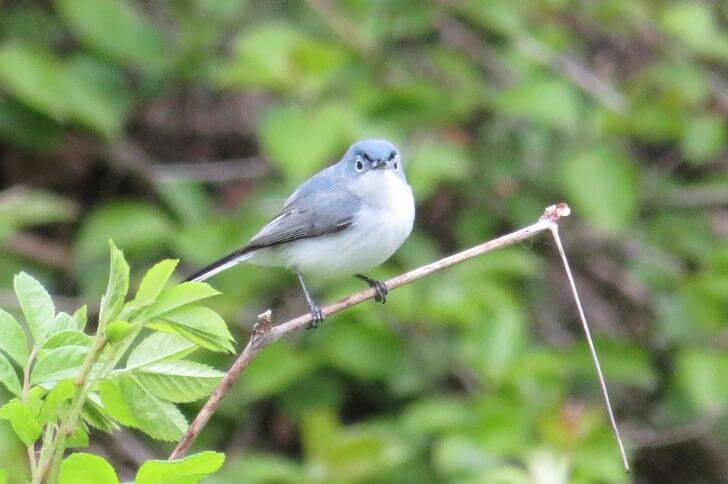
The blue-gray gnatcatcher is a small songbird with a slim build and long tail. It’s a resident breeder in Colorado, which means you can see it from April to May.
Identification:
This common backyard bird has pale blue-gray upperparts, and the underparts are pale gray. Both sexes have a white eyering. Note the white edges on the long dark tail and gorgeous beady eyes.
Other facts:
The breeding habitat of the blue-gray gnatcatcher is open woodlands in Colorado. These birds build their nests in trees or shrubs. The diet of the blue-gray gnatcatcher consists mostly of insects.
21. Downy Woodpeckers
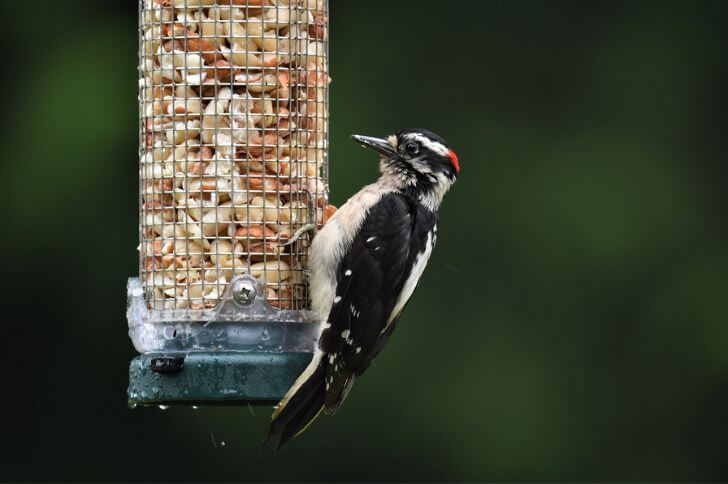
What is the smallest woodpecker in Colorado? Downy woodpecker. Not only are these Denver birds small but also quite interesting to watch.
Identification:
These little birds are black and white, with a striped head, white cheeks, and a white stripe running down their backs. Males have a small red patch on the back of their heads. Downy woodpeckers are 5.5-6.7 inches in length.
Other facts:
Downy woodpeckers are found in woods across Denver Colorado. They nest in trees, drilling holes in dead wood to create a nest cavity. These cute birds favor insects such as spiders and beetles that they find by pecking at tree bark.
These little birds are interesting to watch as they hop up and down tree trunks searching for food. If you’re lucky enough to see one up close, you’ll notice that their tails are quite long and help them to keep their balance as they move around on vertical surfaces.
22. Mourning Dove

Mourning doves are one of the most common birds of Denver. They are all year round residents within this regions.
Identification:
These medium-sized, plump birds are a familiar sight in backyards and parks, and their cooing calls are a fixture of summer mornings. Though they’re not as flashy as some other birds, mourning doves are interesting creatures with a few unusual habits.
The adult is gray above with long and thin tail feathers. Its underparts are peachy colored. Note the black spots on its wings.
Other facts:
Mourning doves are also one of the strongest flying birds in North America, capable of reaching speeds up to 55 miles per hour.
They usually mate for life, and pairs will often build their nests together year after year. During the breeding season, a pair can raise up to 6 broods.
23. Common Grackles
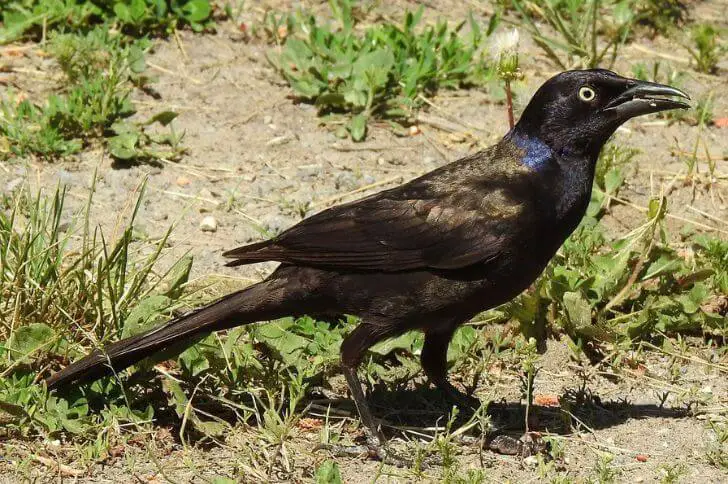
Found in the northern half of Colorado, common grackles are members of the blackbird family.
Identification:
The adult common grackle is about 10-13 inches in length with a wingspan of about 15 inches. The body is iridescent black with a long, slender tail. The head is small and flat with a glossy forehead. The eyes are bright yellow and the bill is long and slightly curved.
Other facts:
Common grackles are found in open woodlands, farmlands, and urban areas. They are social birds and often travel in flocks. Common grackles feed on insects, earthworms, snails, frogs, snakes, lizards, small mammals, and scraps of human food.
24. Buffleheads

One of the cutest ducks in Denver is the bufflehead. Sexually dimorphic and an all year round resident in this state, this is a common bird around lakes and swamps.
Identification:
Buffleheads are small, stocky diving ducks with large, round heads. The males have black and white plumage, while the females are brown and white. Males also has green-purple iridescent faces and a broad grayish bill.
Their body mass ranges from 9.5 to 19.4 oz and a wingspan of up to 21.6 inches long.
Other facts:
Buffleheads breed in northern forests and spend their winters along the coasts of North America. These birds dive for their food, eating small fish, crustaceans, and mollusks.
They build their nests in tree cavities or on the ground near water. What sound do buffleheads produce? Males often produce grating sounds while females are known for “cuk” calls.
25. Turkey Vulture

The turkey vulture, also known as the carrion crow or turkey buzzard, is a large bird that uses Colorado as a breeding ground. Also, the turkey vulture is the most common vulture in the United States.
Identification:
The bird gets its name from its similarity in appearance to the wild turkey. The turkey vulture has a wingspan of up to six feet and can weigh up to four pounds. The bird is mostly black with a bare redhead.
The head of a turkey vulture is small compared to its body size. The eyes of the bird are small yet these birds are known to have keen eyesight and can see carcasses from great distances.
Other facts:
The turkey vulture is a scavenger and feeds on carrion.
FAQs
What birds are native to Denver Colorado?
Denver, Colorado is home to a variety of different bird species. Some of the most common birds that can be found in the area include: American Robins, Bald Eagles, Blue Jays, Canada Geese, and Chickadees. While there are many other types of birds that can be found in Denver, these are some of the most commonly seen.
Denver is a great place for bird watching, as there are so many different types of birds that call the city home. Whether you’re looking to see some rarer species or just want to enjoy the beauty of nature, spending some time bird watching in Denver is sure to be a fun experience.
Does Denver have robins?
No one is quite sure when robins arrived in Denver, but they are now a common sight in the city. Some people believe that the robins are a sign of spring, while others think they are just another bird that has found a comfortable home in the city.
There are many different types of birds in Denver, but the robin is one of the most popular. Some people believe that the robin is a sign of spring, while others think they are just another bird that has found a comfortable home in the city. No one is quite sure when robins arrived in Denver, but they are now a common sight in the city.
Where to go bird watching in Denver?
If you’re looking to bird watch in Denver, there are a few great places to check out. First, head to Rocky Mountain National Park. There are over 280 species of birds that have been spotted in the park, so you’re sure to see something interesting.
Another great spot for bird watching is Cherry Creek State Park. This park is home to a variety of different birds, including herons, eagles, and owls. There are also many different hiking trails that you can take to get up close and personal with the birds.
Finally, don’t forget about the Denver Zoo! The zoo has a variety of different animals, including many different types of birds. You can even take a behind-the-scenes tour to learn more about the care that goes into keeping the birds healthy and happy.
Sources:
https://www.inaturalist.org/guides/6623
https://en.wikipedia.org/wiki/Bufflehead
Hi fellow bird watcher. Welcome to our small corner of the world. At the spanishbirdguides.com our mission is to share with other bird watchers the things we love about birds, where to go bird watching within the United States, and more. I’d also love to hear from you. Feel free to contact me about your bird watching escapades, share videos, photos and more.
